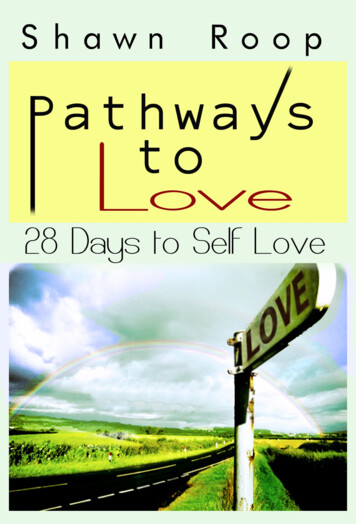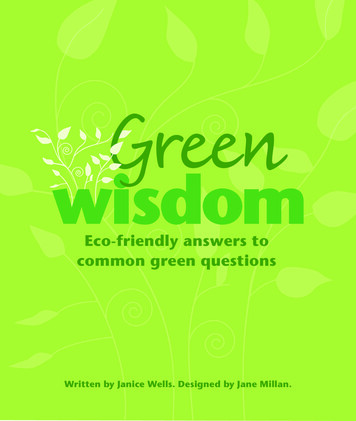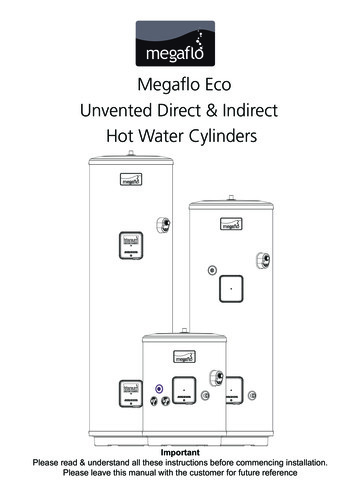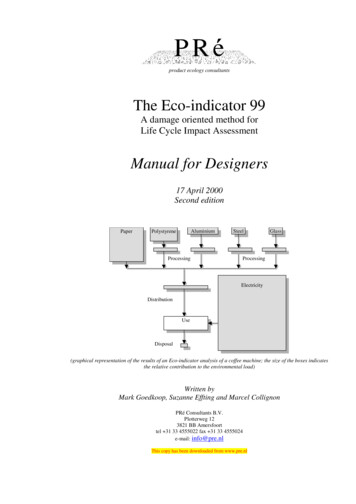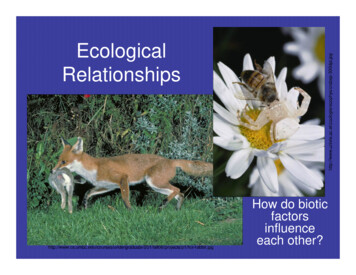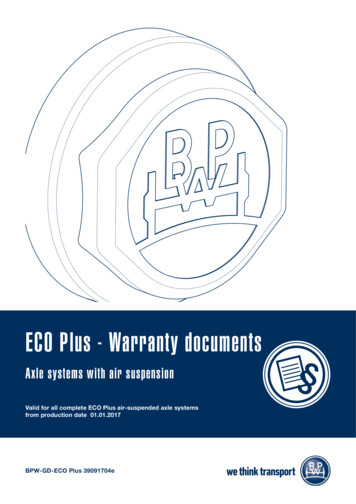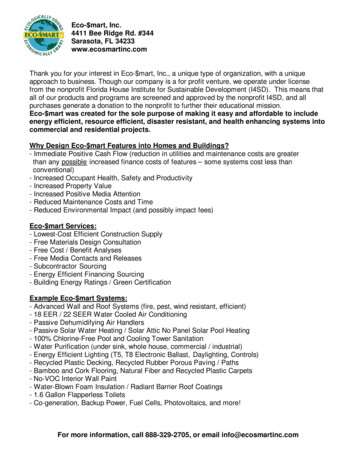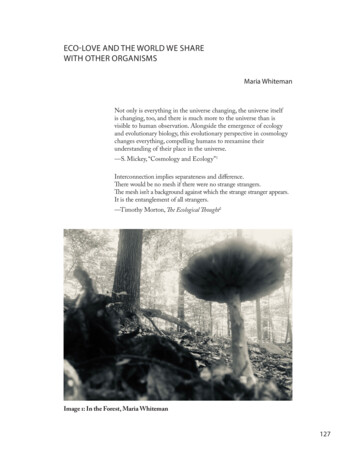
Transcription
ECO-LOVE AND THE WORLD WE SHAREWITH OTHER ORGANISMSMaria WhitemanNot only is everything in the universe changing, the universe itselfis changing, too, and there is much more to the universe than isvisible to human observation. Alongside the emergence of ecologyand evolutionary biology, this evolutionary perspective in cosmologychanges everything, compelling humans to reexamine theirunderstanding of their place in the universe.—S. Mickey, “Cosmology and Ecology”1Interconnection implies separateness and difference.There would be no mesh if there were no strange strangers.The mesh isn’t a background against which the strange stranger appears.It is the entanglement of all strangers.—Timothy Morton, The Ecological Thought2Image 1: In the Forest, Maria Whiteman127
WhitemanFungiIhave walked through forests, every day, for many years. Recently, mytime in the woods has been accompanied by the arrhythmic thrumof climate change buzzing in my head. Since 1880, the average surfacetemperature of the planet has increased by about 1 C (or 2 F) relative tothe mid-20th-century baseline. Climate change has joined the cacophonyin my head by naming a broad range of global phenomena, includingboth the increased temperature trends described by global warming andchanges like sea level rise, ice mass loss in Greenland, Antarctica, theArctic, and mountain glaciers worldwide. These are fueling both speciesinvasion and species extinction, and they are making natural disastersworse. One way to escape the thought of doom is to get out in the woodsand be reminded of what still remains in the landscape.Eco-love is befriending melancholy. It’s a comfortable affair with sadness.It doesn’t own you, nor do you live there. It’s neither negative nor evokes negativity, but rather offers contentment, familiarity, and knowingness.My relationship to walking on trails and being in the woods hasevolved into paying close attention to the natural world, as though walkinginto a Mary Oliver poem. I was hiking with a friend once when we cameacross what looked like someone’s campsite with burnt timber left insidea circle of rocks, cigarette butts everywhere, and next to it a pile of wastewith plastic bottles and oil cans wedged under a rotting log. Only a fewfeet away, a mushroom loomed above the garbage like a superhero. All atonce, the thrum in my head dissipated—an impulse to pay attention. ThereI was, down on my hands and knees, captivated, intrigued, and fascinatedby the color, texture, smell, alien quality, and physicality of that mushroom.After that moment, during my forest walks, I began noticing populations of fungi growing on anything dead in the woods, mostly trees. Odd,strange-looking feral shapes were everywhere breaking through the leaves.I took an interest in learning more about fungi. Anna Tsing’s observation,in The Mushroom at the End of the World, resonated with me: “Mushroomtracks are elusive and enigmatic; following them takes me on a wild ride—trespassing every boundary.”3Trekking on paths that crisscross will send you in various directions; acommon joke among mushroom foragers is that it takes an entire day to hikea mile. My interest in fungi takes me on a journey to the Northwest Cascadesto join mycologist Ja Schindler, who leads fungi workshops on his acreage128
Eco-Lovefour times a year with a group called “Fungi for the People.” The courseimmerses me in fungi: cultivating, cloning, lab work, inoculating, makingsubstrates, sterilizing, pasteurizing, farming, and harvesting. The pleasure atthe end was learning about the medicinal qualities of Lion’s Mane, Reishi,Turkey tails, Chaga, and many other fungi. It is euphoric.My journey continues back in Indiana, as I walk from the woods intomy studio, where I try to link what I’ve learned about mushrooms to theenvironmental changes I experience. I am preparing for an outdoor/indoorart installation, which uses the trans-species imaginaries of fungi to drawawareness to our planetary crises. It is a work of bio-art made out of turkeytails and Reishi. I see it as an act of environmental activism: emphasizing theenvironmental significance of fungi means acknowledging the irreversiblechanges humans have made to fungi ecosystems. By thinking and creatingthrough and with a kingdom of organisms that thrives on decaying matter,my aim is to embed my work in our present moment of ecological collapse.Image 2: In the Forest & Sketches, Maria WhitemanIt is easy to discover this mycelial world of recycling, of decomposition, ofdecay, of matter, of production and reproduction at other-than-human speedsand times. Fungi have alien qualities. They are shape-shifters with caps, stems,scales, gills, veils, and volvae. They release microscopic spores like dust fromunder their caps, where the gills or polypores are located. Getting close to fungi is not always pretty. It can be strange, uncanny, smelly, gross; the mushroom’sworld is one of decay, after all. But fungi love it. The soil is where they decompose organic matter and produce and absorb nutrients they share with therest of the forest. The fungus itself is the fruiting body of a sprawling networkbelow the soil’s surface, a rhizome of connective tissue circulating food to trees129
Whitemanand plants. In exchange for these nutrients, fungi receive carbohydrates. Thefungus doesn’t get food from the sun; it doesn’t have an appetite for photosynthesis.4 The fungus prefers to thrive on rotting matter, on breaking down tissue.Decomposition is a complex process. The fungus’s singled-celled sporestake off like a spindrift from a wavy gill, connected by thin strands called“hyphae.” The hyphae form the mycelium, the stretchy hairs that aid decomposition. Together, they form a perfectly contained reproductive unit thathelps the developing fungus become a fruiting body. The fruiting mushroomis an essential part of a larger underground network that recycles nutrients toreproduce itself as a single organism. The subterranean rhizome in Oregon’sMalheur National Forest is the largest organism on the planet.I shared my fungal stories with my art partner, who had also begunto notice fungi. It was like we were being pulled into a secret. The fungicosmos seemed to be everywhere, bursting through dark and musty leaves.The forest floor, carpeted with mushrooms, seemed no less stunning to usthan stars beamed down in Big Bend or Moab. We started to imagine waysfungi might remedy an ailing planet. We started to witness our own transspecies relationship with fungi. Instead of cotton, perhaps we could wearturkey tails. We joked about mushrooms saving the world, as though PaulStamets had it right all along.5 Perhaps we could learn from the microbialworld where fungi are finding ways to adapt.Eco-love gently holds your hand and draws you into the mysteries andunknowns of the natural world—where you recognize fungi, air, water, andmore as the elements that keep the forest, and us, alive.Image 3: Trans-species with Turkey Tails Trametes Versicolor, Maria Whiteman130
Eco-LoveStrangersMushrooms reaffirm our entanglements with other organisms. There are asmany ecologies inside of us as there are outside of us, if not more, and newresearch shows that organisms like fungi communicate to build relationshipsthat may be styled as commensalism, symbiosis, mutualism, and parasitism.This research further suggests that what we are now witnessing in these fungalforms of communication and relation are effects of and responses to globalwarming. Depending on the species, these changes may be an extra-energeticwork or a resourceful retreat aimed at conserving energy.After a long and engaging conversation with a mycology researcher, Ilearn there is still so much to learn—hopefully before too many fungi speciesbegin to disappear. Peter Byrne points out that communication is what makes“the evolutionary perspectives of cosmology and ecology” view the “worldas dynamic, generative and interconnected.” For instance, an importantprinciple of quantum biology states that if “two or more atomic particles areentangled, . information can be transferred between them instantaneously,no matter how far apart they are, even light-years.”6 An organism’s abilityto communicate affects its entire community of communities. Mushroomscommunicate through their rhizome network. An alert system signals apending threat through the filaments. In mutualistic relationships, a speciescan communicate danger by retreating from the relationship.7 Threatsprolonged by disease, drought, flood, or fire can cause lasting, possiblyirreversible, damage to mutualistic exchange. Like humans, fungal speciesmigrate once they lose their homes or environments.The expression “strange and strangers” comes to mind each time I witnessa fruiting body that shows its strange fungal structure. To me such fruitingexemplifies our relationship to these organisms we know so little about: notjust fungi, but also lichen, moss, and many marine life forms. These strangelooking creatures seem “other to other” in our everyday reality, and yet theyare linked to our world in deep ways. Strange and stranger organisms linkthe world across and between the elements: the air we breathe and water wedrink. Timothy Morton draws on Derrida to observe that “hospitality,” orwelcoming-ness to strangers, is premised on the possibility of welcomingan absolutely strange and even hostile other. “Host,” “hostile,” and “hospital”share a root. Evolution presents us with unpredicted arrivals all the time inthe house of ecology (oikos house)—the Derridian logic applies.8 Life formsdeep in the sea and fungus found in moist climates are irreducibly strange;131
Whitemanthe more you find out about them, the stranger they become. Strangersmesh. The notion of meshing sounds elementary, but it is complex, a perfectmetaphor for fungi’s status in our biodiverse world. In what form can wewelcome our strange friends into our homes—or is it the other way around?Image 4: Mycelium under the Microscope, Maria WhitemanLet’s move from the elemental to the hyper-objective. Morton’sconcept of the “hyperobject” names an all-encompassing affect, or akind of omnipresent climate.9 It suggests the possibility of variousmutual interdependencies, through which we might uncover a betterunderstanding of home. Could a rhizome provide a structure for ourhyperobject’s home?10 Deleuze and Guattari write:Unlike a structure, which is defined by a set of points and positions, withbinary relations between the points and biunivocal relationships betweenthe positions, the rhizome is made only of lines: lines of segmentarity andstratification as its dimensions, and the line of flight or deterritorializationas the maximum dimension after which the multiplicity undergoes metamorphosis, changes in nature.11The rhizome makes possible Tsing’s assemblages: the matsutake mushroomsthat bring together, collect, and interconnect; the “ecological communitiesand open-ended gatherings” exemplified by fungi markets.12132
Eco-LoveImage 5: Mycelium and Gills, Maria WhitemanWe can imagine a mycelial map connecting oil, energy, consumption, and waste. Fossil fuels are devastating our planet. Fungi, in all theirornamental forms, have been responding to changing climates for muchlonger than humans. If fungi and lichen were sequestering high levelsof carbon dioxide several million years ago, they are well-accustomed toregulating the atmosphere. Can fungi absorb chemicals and metals, anduse their enzymes to break down plastics? Where does it go from there?Might the rhizome, exquisitely self-contained and neither needing noranticipating interpretation nor response, provide us with an escape routefrom climate change, one that’s been there since the rhizome emergedhundreds of millions of years ago?In considering the new understandings of ecology that are opened up byan exploration of this underground world, I recall Fredric Jameson’s statement:“it is easier to imagine the end of the world than to imagine the end ofcapitalism.”13 This is one of the most uncompromising statements of our time,a moment when capitalism’s god is growth and our environment its sacrificiallamb. My question is: How would mycelia respond to Jameson’s statement? Isthere a mycelial economics? A mycelial architecture? If so, what would it teachus? Could its teachings change the constellation of ruins we leave behind foranother era to explore? And who, after all, is “we”?133
WhitemanNel mezzo del cammin di nostra vitami ritrovai per un selva oscuraché la diritta via era smarrita.14Image 6: Figures: Mushroom Substrate, Maria WhitemanEco-LoveWhat steps should we take if we want to produce real, sustainable change?It might be best to start with a management program, a methodology thatcan shed light on dark shadows and help us love dystopian worlds. Let’scall it eco-therapy: once we can love ourselves (our planet), we enter thenext stage of eco-love. In saying “we,” I point to all humankind but mostlyto developed nations that cause most greenhouse gas emissions. Optimismis defined as being hopeful, positive, and sanguine. Those words remind meof times my mother would tell me to smile and be happy. It’s like a switchthat can be turned on or off. Are we stuck wrapping a band-aid around theplanet, or can capitalism go green?Eco-love evolves out of the dismal facts of climate change and its dystopian ruins. It’s best to begin at the dead center of the ruins engulfing ourplanet. A wound in the belly. Perhaps it isn’t so far from the idea of thepantheon (a temple built to last thousands of years). We are better than theRomans: we are leaving plastic ruins to last forever. We begin to accept ourgarbage, our baggage. We begin to co-exist, to love dystopia and our ruinsas a place to begin again. Oil, pollution, carbon, particulate toxins, pesticides, plastics: all this can be found in the bellies of fish and albatrosses.134
Eco-LoveWhat is a belly but the trunk of a torso where the stomach and bowels live?Its Germanic root means to swell or inflate, like a beer belly. Our ruins arecausing serious bellyaches. Our planet is ill, deflated. Meanwhile humansinflate, making everything bigger and consuming more. We have to inflateour spaces so that everything becomes synchronous.Monumental growth is occurring in landfills—a mound transforminginto a mountain of human debris that can’t stop subsuming, consuming, indulging, ingesting, and devouring. It takes truckloads to keep the belly fed.It has to ingest and indulge—to keep getting substantially bigger. Climatechange is a combination of symptoms that are getting worse. These symptoms appear not only in the weather, but also in entire ecosystems, includingfungi. We might correct our myopia by learning more about the mycelialcosmos that lives underground and which is cosmically linked to the tilting of the earth. It might be a good time to ask whether this undergrounduniverse can teach us something about treating the symptoms of a warmingplanet—resourcefulness and energy conservation, for a start.Walking in the woods early in the morning, as I fall back into mymelancholic eco-love affair, my dismal thoughts are interrupted by thehumming of the birds, trees, wind, and fungi that look like stars blanketingthe ground. They will be gone by the afternoon—but if you look long enoughyou may see something spectacular.Image 7: Mycelium under the Microscope, Maria Whiteman135
WhitemanNOTES1S. Mickey, “Cosmology and Ecology,” The Encyclopedia of the Anthropocene, Volume 4, eds. Dominick A. Della-2Timothy Morton, The Ecological Thought (Cambridge: Harvard UP, 2010), 47.3Anna Tsing, The Mushroom at the End of the World: On the Possibility of Life in Capitalist Ruins (Princeton:Sala and Michael I. Goldstein (Oxford: Elsevier, 2018), 153.Princeton UP, 2017), 137.4Steven Stephenson, The Kingdom Fungi: The Biology of Mushrooms, Molds and Lichens (Portland: Timber Press,2010), 13-16.5Paul Stamets, Running Mycelium: How Mushrooms Can Save the World (Berkeley: Ten Speed Press Berkley,2005), 12.6Peter Byrne, “In Pursuit of Quantum Biology With Birgitta Whaley,” Quanta Magazine, July 30, chard Karban, “The Language of Plant Communication (and How it Compares to Animal Communication),”The Language of Plants: Science, Philosophy, Literature, eds. Monica Gagliano, John C. Ryan, and Patricia Vieira(Minneapolis: University of Minnesota Press, 2017), 3.8Timothy Morton, The Ecological Thought, 275.9Timothy Morton, Hyperobjects: Philosophy and Ecology at the End of the World (Minneapolis: University ofMinnesota Press, 2013).10Timothy Morton, The Ecological Thought, 278.11Gilles Deleuze and Félix Guattari, A Thousand Plateaus: Capitalism and Schizophrenia, trans. Brian Massumi(London: Continuum, 2004), 23.12Tsing, The Mushroom at the End of the World, 138.13Fredric Jameson, “Future City,” New Left Review 21 (May/June 2003): 76.14Translation: “Midway upon the journey of our life/ I found myself within a forest dark,/ For the straightforward pathway had been lost.” Dante Alighieri, The Divine Comedy of Dante Alighieri: Inferno, Purgatory,Paradise, ed. and trans. Henry Wadsworth Longfellow (Boston: J.R. Osgood, 1867), canto I, lines 1-3.136
changes like sea level rise, ice mass loss in Greenland, Antarctica, the Arctic, and mountain glaciers worldwide. These are fueling both species invasion and species extinction, and they are making natural disasters worse. One way to escape the thought of doom is to get out in the wood
